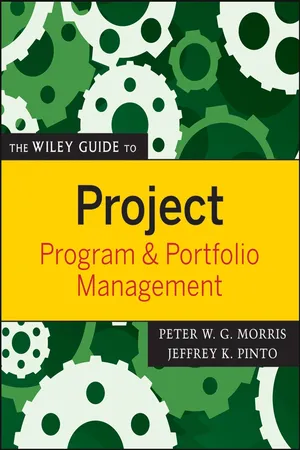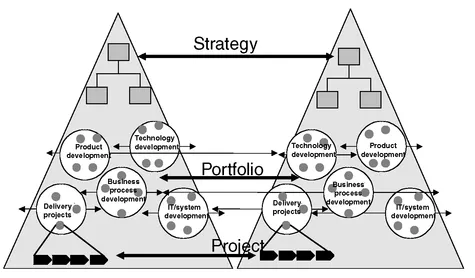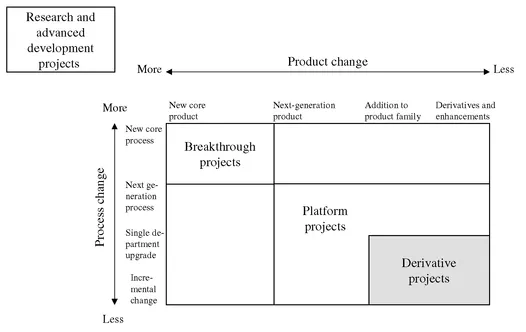![]()
CHAPTER ONE
STRATEGIC BUSINESS MANAGEMENT THROUGH MULTIPLE PROJECTS
Karlos A. Artto, Perttu H. Dietrich
Effective management of single projects does not suffice in today’s organizations. Instead, the managerial focus in firms has shifted toward simultaneous management of whole collections of projects as one large entity, and toward effective linking of this set of projects to the ultimate business purpose. This approach is contained in concepts of project-based management, programs, and portfolios. Portfolios of different project types are typically positioned under the governance of organizational units or responsibility areas (see Figure 1.1). Management processes above projects must link projects to business goals and assist in reaching or exceeding the expectations set by company strategy.
One major starting point for the development of business-oriented management of projects in a company context was introduced in the end of 1980s in an expert seminar in Vienna, where the contribution of project management to the general world of management was discussed as contained in the concept of “management by projects” (see the chapter by Gareis). Since that time there have been an increasing number of studies on the broader role available for project-based management, project-based organizations, and project business. Recent examples of such studies include Turner (1999), Turner and Keegan (1999, 2000), Turner et al. (2000), Gareis (2000a, 2000b), Artto (2001), Artto et al. (2002), and Elonen and Artto (2003).
Early theories of organizational strategy saw “strategy as an action of intentionally and rationally combining selected courses of action with the allocation of resources in order to carry out organizational goals and objectives in order to achieve strategic fit and thereby obtain competitive advantage” (Hatch, 1997). This is based on the idea that strategy involves creating a match between organization and environment (Ansoff, 1965). Galbraith (1995) proposed that strategy establishes the criteria for choosing among alternative organizational forms. Each organizational form enables some activities to be performed well while hindering others. Choosing between organizational alternatives involves trade-offs. Strategy can help with this by pointing to those activities that are most necessary, thereby providing a basis for making the best trade-offs.
FIGURE 1.1. TWO COMPANIES (OR TWO BUSINESS UNITS WITHIN ONE COMPANY) WITH NETWORKED PROJECTS AND PORTFOLIOS. THERE ARE CROSS-ORGANIZATIONAL PROCESSES IN THE SHARED NETWORK AT STRATEGIC, PORTFOLIO, AND PROJECT LEVELS.
Source: Artto et al. (2002).
The purpose of this chapter is to introduce managerial practices relevant to strategic business management in multiple-project environments. Multiproject environments are introduced in terms of different project types, programs, and portfolios and their management. Based on the knowledge from this, we introduce issues that serve as guidelines to the theme of strategic business management of multiple projects. We conduct an analysis of content and process of strategy and how these relate to the setting of goals and objectives, and to effective decision making with multiple projects. Based on this, the chapter identifies effective managerial practices for the strategic business management in multiple-project environments. We also combine strategy with management from an applications viewpoint by looking at four case organizations.
Different Project Types and Their Different Strategic Importance
Different project types have different strategic importance; each type typically requires different management approaches. Crawford et al. (2002), Shenhar et al. (2002), and Youker (1999) are studies of project classification that attempt to address this issue. (See Shenhar and Dvir’s chapter in this book.) These are valuable in understanding not only different project types and their characteristics but also the different success criteria and respective strategic importance, and accordingly, different successful managerial practices associated with each project type.
Shenhar et al. classify projects into external and internal types, where the position or closeness of the customer (external or internal) provides the basis for the classification. This classification also considers the ultimate customer in the external markets in relation to how direct or indirect the relationship of the ultimate customer is to the project deliverable. Their starting point is innovation management literature that makes a distinction between incremental and radical innovation. Thus, according to Shenhar et al., projects can be either strategic or operational in their nature, depending on the project type.
External projects typically relate to developing products for customers in the market. Shenhar et al. distinguish between derivative, platform, and breakthrough projects, all as external projects. Wheelwright and Clark (1992) call these three project types commercial development projects. Based on Shenhar et al.’s considerations, derivative projects relate to extending, improving, or upgrading existing products. They typically aim at short-term benefits, and they are thus more operational than strategic in their nature. Platform and breakthrough projects relate to new product development or production processes where there is a longer-term perspective, and, accordingly, a reaching for a more strategic nature. Another interpretation of an external project is that of a delivery project where the project is in a commercial setting, and where an organization is running projects for other organizations (Turner and Keegan, 1999). Such external delivery projects are often mere production or manufacturing devices that run more or less predetermined work for an organization according to a contract between the customer and project supplier (Artto, 2001). The similarity of project-based operations with both external and internal customers is demonstrated by Turner and Keegan (1999), who defined a project-based organization as a stand-alone entity that makes products for external customers, or a subsidiary of a business unit of a larger firm that makes products for internal or external customers.
Shenhar et al. (2002) divide internal projects into problem solving, utility, maintenance and research projects. Wheelwright and Clark (1992) distinguish between internal projects based on research and development, which are a precursor to commercial development, and alliances and partnerships, which can be commercial or basic research directed. Figure 1.2 describes Wheelwright and Clark’s view on different types of development projects (the figure includes four types; the fifth type—alliances and partnerships—can include any of the other four types). Mikkelsen et al. (1991) define internal projects as organizational or operational development projects, such as systems planning and implementation, the introduction of new manufacturing technology, and organizational change. Shenhar et al.’s utility and research projects usually come from a long-term perspective and can be considered as strategic projects. Problem-solving and maintenance projects usually focus on the shorter term, typically aim at performance improvements, and can be seen as operational projects (Shenhar et al., 2002).
We appreciate the consideration of strategic importance now given to project types but consider that the “strategic versus tactical” importance given to these also depends on parameters other than project type as defined by existing project classification literature. Fur-thermore, the strategic importance cannot be evaluated in a straightforward manner, such as presuming that long-term projects are always more strategic, as is widely argued in the literature.
FIGURE 1.2. MAPPING THE TYPES OF DEVELOPMENT PROJECTS.
Source: Wheelwright and Clark (1992).
Programs and Portfolios
Guidance for the management of multiple projects in organizations can be derived from several different theoretical and practically oriented discussion arenas. The program management and project portfolio management contents are outlined in the following section.
Archer and Ghasemzadeh (1999) define a project portfolio as a group of projects that are conducted under the sponsorship or management of a particular organization (see their chapter in this book). They point out that these projects compete for scarce resources. The three well-known objectives of portfolio management are as follows (Cooper et al., 1998):
• Maximizing the value of the portfolio
• Linking the portfolio to the strategy
• Balancing the portfolio
Dye and Pennypacker (1999) define project portfolio management as the art and science of applying a set of knowledge, skills, tools, and techniques to a collection of projects to meet or exceed the needs and expectations of an organization’s investment strategy. In PMBOK (2000), project portfolio management refers to the selection and support of project investments or program investments that are guided by the organization’s strategic plan and available resources. A strategic task of project portfolio management is to maintain corporate identity and ensure linkages between projects and constrain the impact of individually implemented projects with no links to other projects (Lundin and Stablein, 2000). According to Platje et al. (1994), a portfolio is a set of projects that are managed in a coordinated way to deliver benefits that would not be possible if the projects were managed independently. This definition is similar to many definitions introduced for a project program. For example, Turner (1999) and Poskela et al. (2001) emphasize that projects in a program are a coherent group that is managed in a coordinated way for added benefit. Murray-Webster and Thiry (2000) define a program as a collection of change actions (projects and operational activities) purposefully grouped together to realize strategic and/or tactical benefits. (See the chapter by Thiry on program management.)
From the strategic management point of view, the main driver for the management of multiple projects in different forms—for instance, programs—is the change in the business environment of an organization (OGC, 2002). Changes in the environment imply system or organizational changes (Ackoff, 1999). In these changes, program management provides a framework for the management of complexity and risk with the general intent of implementing business strategies and initiatives, or large-scale change (OGC, 2002).
The management of risk and uncertainty can appear in different ways. For example, in the R&D area, the important task of a business manager may be to increase risk to balance the portfolio of projects for business benefit. We can see this from findings illustrating how radical projects with high risk have the highest business potential (Loch, 2000).
Programs usually represent entities that have a determined purpose, predefined expectations related to the benefits scheme, and an organization, or at least a plan for organizing the effort. A program is set up to produce a specific outcome that may be defined at a high abstraction level of a “vision.” According to PMBOK (2000), a program consists of several associated projects that will contribute to the achievement of a strategic plan. Many programs also include elements of ongoing operations. Program management helps to organize, manage, accommodate, and control adaptation and changes such that the eventual outcome meets the objectives set by the business strategy (OGC, 2002). Program management includes the management of interfaces between projects, prioritization of resources, and a reduction in overall management effort (Turner, 1999). The objectives of projects under the same project program are interdependent (Platje et al., 1994). Turner (1999) emphasizes the importance of the overall strategic resource sharing scheme related to program management. Such strategic resource sharing is implemented through a well-organized balance of responsibility, where the program directors’ responsibility is to link programs with corporate objectives, the overall corporate plan, and corporate resource plan. OGC (2002) defines program management as the coordinated management of a portfolio of projects that change organizations to achieve benefits that are of strategic importance.
Constructing a Theoretical Framework
The previous sections introduced aspects of existing knowledge on multiproject environments and attempted to show the need for new knowledge in the area of strategic business management of multiple-project environments. Based on this analysis, and the needs reflected by it, we can identify the following issues:
1. How can multiple projects be collectively aligned with business strategy in a manner that generates enhanced benefits for the whole business?
2. What is the role of specific projects in implementing, creating, and renewing business strategies?
3. How best can strategic business management be applied in organizations with multiple projects, and what are the relevant managerial practices for accomplishing this?
The preceding three questions are addressed in this remainder of this chapter via current strategy, business administration and project management literature, as well as findings from four case organizations.
Strategy and Strategic Management
In ancient military terminology in Athens, Strategos referred initially to attributes of the general commander in the army. The word strategy later was expanded to include the art of managerial skills for employing forces to overcome opposition (Mintzberg et al., 1995). Ancient military terminology and early strategic management literature emphasize the relative position of an organization to its external competitive environment, with emphasis on activities necessary to achieve a desired position (Chaffee, 1985). The concept of strategy has also used contributions from other disciplines, such as industrial organ...



